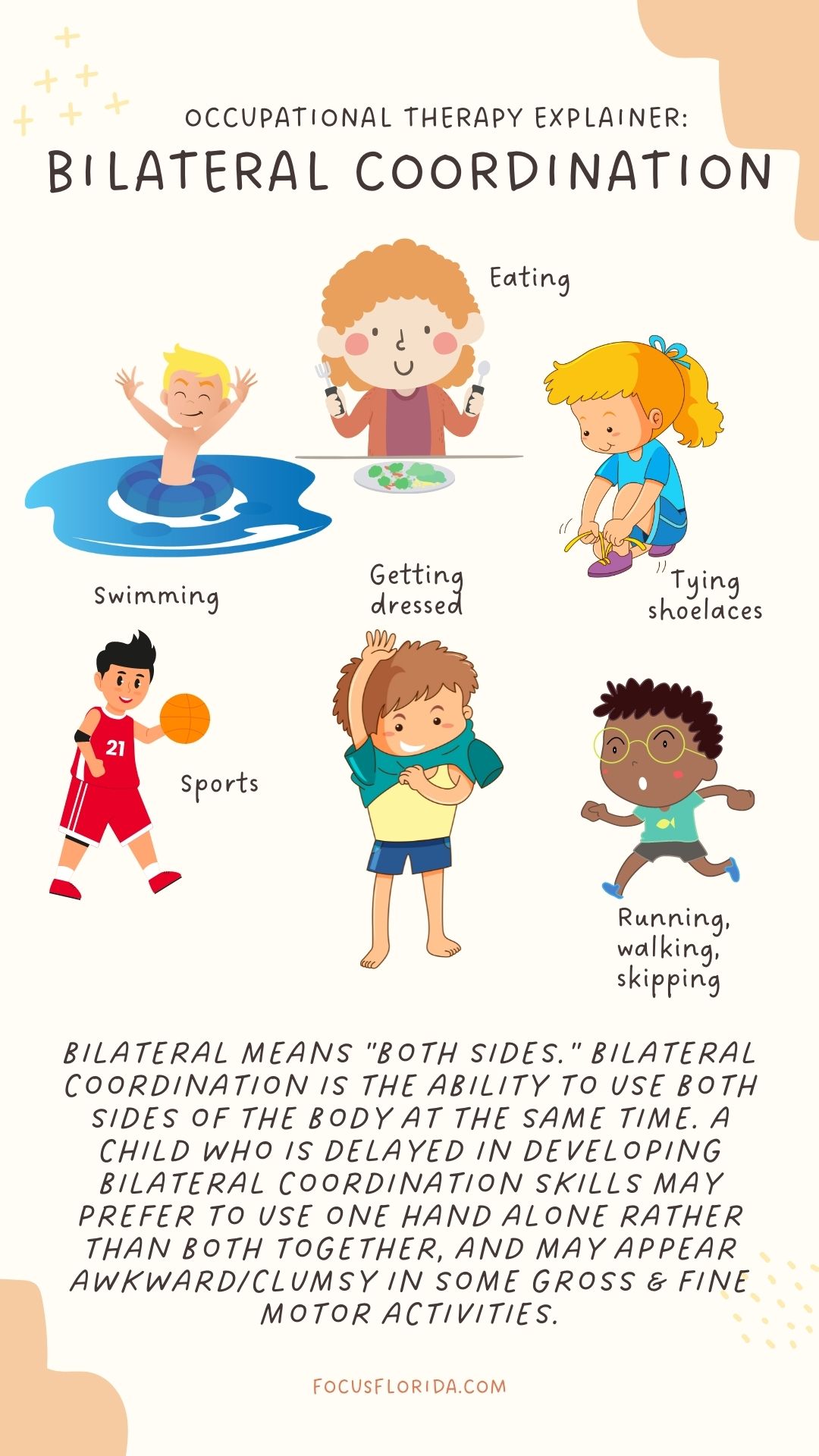Blog

Bilateral Coordination, Explained by Fort Myers Pediatric Occupational Therapists
Bilateral coordination, sometimes referred to as bilateral integration, is a critical developmental skill with which some kids struggle. It involves using both sides of the body together, and can impact both fine and gross motor skills Children who have difficulty with bilateral coordination may be diagnosed solely with developmental coordination disorder, but it’s also closely associated with other conditions such as autism spectrum disorder, Down syndrome, cerebral palsy and other developmental delays and disorders.
As Fort Myers pediatric occupational therapists, we recognize there’s been an increasing awareness about what bilateral coordination is as well as what deficits might look like. A reported uptick in bilateral coordination deficits could also be partially attributed to COVID closures, as lots of kids lacked regular exposure to certain activities (PE class, playground time, etc.) that can help build these skills.
How Do I Know If My Child Has Poor Bilateral Coordination?
Some indicators of poor bilateral coordination include:
- Trouble cutting with scissors.
- Struggles with handwriting.
- Difficulty tying shoes.
- Having a hard time dressing themselves (pulling on socks, pants, and shoes).
- Trouble with fasteners, like buttons, zips, or snaps.
- Clumsy movements.
- Trouble catching a ball.
- Awkward clapping.
- Troubling using a bicycle pedal.
Parents should note there are actually three different types of bilateral coordination: Symmetrical, reciprocal and leading/supporting.
Symmetrical movements are those that require both sides of the body working in synch at the same time to accomplish a given task. Using both hands to roll out a play dough snake or clap would be examples of symmetrical movements. Watch out for your child using one hand for something that needs two or preferring to have one hand do more of the work (the movement will end up lopsided).
Reciprocal movements, also sometimes referred to as alternating, is another type of bilateral coordination. As our Fort Myers pediatric occupational therapists can explain, this occurs when one side of the body completes a movement that is then repeated on the other side of the body. This would include things like crawling, walking, running, skipping, and swimming. One side of the body moves forward, then the other repeats, and so on. Your child may struggle with this if you notice the movements to be jerky or lack good flow.
Finally, there are leading and supporting movements. These types of bilateral coordination movements occur when both sides are needed to complete the movement. Handwriting is a great example: You need one hand to do the writing, but the other must simultaneously hold down the paper. Issues with leading and supporting movements can be identified by things like awkward positioning (the supporting hand isn’t properly helping the leading hand), the child can’t keep straight lines with activities like cutting or drawing.
A lot of times, we’ll notice kids with bilateral coordination difficulties will avoid certain tasks altogether because their harder. Bilateral coordination issues can make even seemingly simple tasks frustrating. Part of what we do as OTs is work consistently on games and activities that specifically target development of these skills. The sooner we can intervene, the less “catching up” a child has to do.
What we also do is help parents identify games and exercises they can do at home with their child for extra practice and improved carryover into other environments.
Activities for Practicing Bilateral Integration
You can incorporate bilateral coordination practice in games, chores, and everyday activities. Some examples:
- Hand clapping games (check out these 10 classic handclapping games here).
- Doing the dishes. Playing in soapy bubbles can be a blast – have them “help” using a washcloth and a few spoons or plastic plates to wash and dry.
- Pasta stringing. Making “jewelry” out of pasta can be a lot of fun, and it’s excellent for practicing those fine motor skills requiring bilateral coordination.
- Scissors. There are lots of crafts that require cutting – help them get as much practice at home with these scissor skills crafts.
Our OTs can give you lots of other suggestions if you’re stuck. Working on bilateral coordination is a key skill your child will use their whole life. If you notice they’re behind with it, talk to your pediatrician for a referral to occupational therapy for a full assessment.
FOCUS offers pediatric occupational therapy in Fort Myers and throughout Southwest Florida. Call (239) 313.5049 or Contact Us online.
More Blog Entries:
Understanding Pediatric Occupational Therapy, Dec. 4, 2021, Fort Myers Occupational Therapy

Comments are closed.